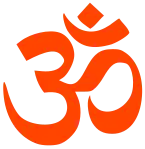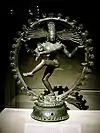Mahāmrityunjaya Mantra
The Mahamrityunjaya Mantra (Sanskrit: महामृत्युंजय मंत्र or महामृत्युञ्जय मन्त्र, mahāmṛtyuṃjaya mantra or mahāmṛtyuñjaya mantra, lit. "Great Death-conquering Mantra"), also known as the Rudra Mantra or Tryambakam Mantra, is a verse (sūkta) of the Rigveda (RV 7.59.12). The sūkta is addressed to Tryambaka, "The Three-eyed One", an epithet of Rudra who is identified with Shiva in Shaivism. The verse also recurs in the Yajurveda (TS 1.8.6.i; VS 3.60).
| Shiva | |
|---|---|
 Raja Ravi Varma's Kalantaka depiction | |
| Devanagari | कालान्तक |
| Affiliation | Shiva |
| Part of a series on |
| Hinduism |
|---|
 |
|
The mantra
The Mahamrityunjaya Mantra reads:
- ॐ त्र्य॑म्बकं यजामहे सु॒गन्धिं॑ पुष्टि॒वर्ध॑नम् ।
उ॒र्वा॒रु॒कमि॑व॒ बन्ध॑नान् मृ॒त्योर्मु॑क्षीय॒ माऽमृता॑॑त् ।।[1] - oṃ tryambakaṃ yajāmahe sugandhiṃ puṣṭi-vardhanam
urvārukam iva bandhanān mṛtyor mukṣīya mā 'mṛtāt[2]
Word-by-word meaning of the Mahamrityunjaya Mantra is as follows:
- ॐ aum = is a sacred/mystical syllable Aum in Hinduism, Jainism, Buddhism & Sikhism
- त्र्यम्बकम् tryambakam = the three-eyed one (accusative case)
- त्रि tri = "three"
- अम्बक ambaka = "eye"
- यजामहे yajāmahe = "we worship, we sacrifice" (1st person plural present indicative ātmanepada of *yaj-)
- सुगन्धिम् sugandhim = "the fragrant, the virtuous, the supreme being" (accusative case),
- पुष्टिवर्धनम् puṣṭi + vardhanam = "the bestower of nourishment, wealth, perfection" (compound word, accusative case), literally "him who possesses the growth of nourishment"
- पुष्टि puṣṭi = "nourishment, increase, wealth, perfection"
- वर्धन vardhana = "increase, growth"
- उर्वारुकम् urvārukam = "fruit, a kind of cucumber" (neuter, nominativ case);
- इव iva = "as"
- in devanagari written together as उर्वारुकमिव urvārukamiva
- बन्धनान् bandhanān = "from bondage, from the stalk/stem" (ablative case, the ending is actually -āt, which changes to -ān because of sandhi)
- Note: bandhanāt here means "from the stem". Thus, read with urvārukam iva, "as a fruit from the stem"; the etymologically prior meaning of "from bondage" resonates here as the fruit is a simile for the worshipper being released from the bondage of death, see below.
- मृत्योः mṛtyoḥ = "from death" (ablative case from mṛtyuḥ, "death")
- मुक्षीय mukṣīya = "may I be freed/released" (1st person singular present optative ātmanepada of the root muc-)
- by sandhi, the last two words become मृत्योर्मुक्षीय mṛtyormukṣīya
- मा ऽमृतात् mā 'mṛtāt = "not (mā) mortal(mṛtāt)" immortal (ablative case from amṛtam): negative particle mā is also constructed together with mukṣīya.
- the last two words become मा ऽमृतात् mā-amṛtāt, free from death into immortality
Origin
According to the some source, Markandeya was the creator of this mantra. The Moon was once in trouble, when cursed by King Daksha. Markandeya gave the Mahamritryunjaya Mantra to Sati, Daksha's daughter, for the Moon. According to another version this is the Bija mantra as revealed to Rishi Kahola that was given by Lord Shiva to sage Sukracharya, who taught it to Rishi Dadhichi, who gave it to King Kshuva, through whom it reached the Shiva Purana.
This mantra is also called the Rudra mantra, referring to the furious aspect of Shiva; the Tryambakam mantra, alluding to Shiva's three eyes; and it is sometimes known as the Mrita-Sanjivini mantra because it is a component of the "life-restoring" practice given to the primordial sage Sukracharya after he had completed an exhausting period of austerity. Its Devata (patron deity) is Rudra, i.e., Shiva in his fiercest and most destructive roopa or aspect. In the Vedas it finds its place in three texts – a) the Rig veda VII.59.12, b) the Yajur Veda III.60, and c) the Atharva Veda XIV.1.17.[3]
Significance
It is said to be beneficial for mental, emotional and physical health and to be a moksha mantra which bestows longevity and immortality.[4]
According to some puranas, the Mahamrityunjaya Mantra has been used by many rishis as well as Sati during the time when Chandra suffered from the curse of Prajapati Daksha. By reciting this mantra, the effect of the curse of Daksha, which could make him die, slowed, and Shiva then took Chandra and placed it upon his head.
This mantra is addressed to Shiva for warding off untimely death.[5] It is also chanted while smearing Vibhuti over various parts of the Body and utilised in Japa or Homa (havan) to get desired results. While its energy protects and guides the initiates a mantra re-links consciousness to its deeper and more abiding nature and repetition of the mantra constitutes Japa, the practice of which develops concentration that leads to a transformation of awareness. Whereas the Gayatri Mantra is meant for purification and spiritual guidance, the Mahamrityunjaya Mantra is meant for healing rejuvenation and nurturance.[6]
See also
References
- Rg Veda with Sayana's Commentary Part 3.
- "The Rig Veda in Sanskrit: Rig Veda Book 7: Hymn 59". www.sacred-texts.com. Retrieved 28 January 2021.
- Swami Vibhooti Saraswati. "Mahamrityunjaya Mantra-Door into Eternal Life".
- Vishnu Devanand. Meditations and Mantras:An Authoritative Text. New Delhi: Motilal Banarsidass Publishers. p. 63.
- David Frawley. Mantra Yoga and Primal Sound. Lotus Press. p. 158.
- Rolf Sovik. Moving Inward:The Journey to Meditation. Himalayan Institute Press. p. 162.
